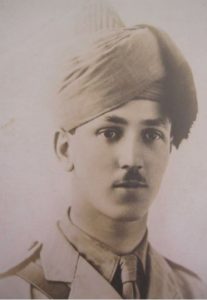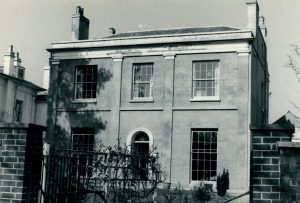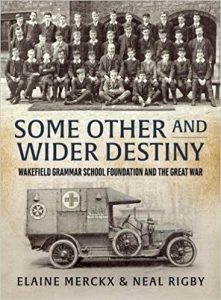An ‘Old Savilian’
In my previous blog when I told you about the book written by Elaine Merckx and Neal Rigby – ‘Some Other and Wider Destiny – Wakefield Grammar School Foundation and the Great War’. Continuing the Wakefield Grammar School theme, I thought I would tell you about one of the young men mentioned in the book.
I have looked at every photograph in the book and there are many including a number of sports-related images, I was drawn to the photographs of the men and boys in the Roll of Honour section. As with any collection of photographs, there is always one that stands out from the crowd – this time it was the turn of John Laurence Young Ottley, not because of his name but because of the uniform he was wearing.

John Laurence Young Ottley wearing the uniform of the Punjabi Rifles
John Laurence Young Ottley was born on April 20th, 1898 and baptised in Wakefield Cathedral on June 3rd of the same year. He was the son of John Bickersteth and Margaret Ottley nee Wray. The family lived at 6 Bond Terrace, Wakefield. His father giving his profession as Solicitor and Official Receiver in Bankruptcy.
Three years later in 1901, at the time the census was recorded, the family were living at 1 Hatfeild Street, Wakefield. John B Ottley gave his age as 56 and being born in Acton, Suffolk. His wife, Margaret, was 36 years of age and born at Newmillerdam, Wakefield. Young John, now aged three had an older sister, Sarah M B (Sarah Margaret Bickersteth) Ottley, well older by one year! Also living with the family was Margaret’s elder sister Ann Wray.
The 1911 census gives a lot more information than previous documents of the same kind. This census is, however, allows for the head of the family to add or exclude information they deem fit. For example Mr Ottley, not only writes that he is the head of the family he includes ‘Head of the family’. He tells that he and his wife have had five children, but one has died. Although all the ages of John’s children are included he seems fit to add that ‘all under 15’. Mr Ottley and I feel by his writings in the census that I should call him Mr Ottley adds that he is both a worker and employer clerks and that he works at his offices at 6 Bond Terrace, which at one time was the family home. Mr Ottley seems to have been a bit of a ‘stickler’ as he goes on to tell that Newmillerdam was at Sandal, nr Wakefield. He tells that he and his family are ‘British Subject by parentage’. He includes their 16-year-old servant from Ackworth, Margaret O’Hara as a British Subject. In the final column, he writes ‘None of the Residents in this house are either wholly or partially Blind deaf or dumb lunatics or imbiciles DG JDC (initials)‘. Home for the family at this time was 12 Wentworth Terrace, Wakefield, a nine-roomed house.
John Laurence Young Ottley’s older sister, Margaret was not living with the family at the time the census was taken. Where was she? She was living with her Aunt Caroline A Ottley, aged 62, who lived by private means. Living with them was Muriel K Ottley, Sarah’s 16-year-old cousin. Muriel had been born in Bakloh, India, but was a British Subject by parentage – it seems the family liked these words. Both cousins were at school but home for this period in their lives was 38 Britannia Square, Worcester. No 38 Britannia Square seems to be of some architectural importance according to Historic England as an entry reads:
Villa. c1820 with later additions and alterations. Painted stucco over brick with hipped slate roof, rebuilt end stacks (2 per end) with string course and pots. Parapet gutter to facade. Central hallway, double-depth plan. 2 storeys with attic. 3 first-floor windows. Stucco detailing includes plinth; full-height Doric-style pilasters to ends and between windows; first-floor band; frieze, cornice and blocking course. Outer bays have 8/8 sashes, centre first-floor 6/6 with margin lights of coloured glass. Ground-floor windows are tall 8/12 sashes. Entrance door is 4-panel; fanlight with radial glazing bars. Flat-topped gables with copings and casement window to attic. INTERIOR: Retains original plasterwork and joinery including narrow open well staircase with stick balusters and wreathed handrail; white marble fireplace to left ground-floor room; moulded cornices, that to hall has decorative frieze with modillions and anthemion design. A similar design to No.39

38 Britannia Square via Britanniasquare.org
This house does seem to fit in with the status of the family, as John Bickersteth and Caroline (Agnes) were two of the children of Laurence Ottley (and his wife Elizabeth Bickersteth), who in turn was the son of Sir Richard Ottley (and his wife Sarah Elizabeth Young).
By visiting Britanniasquare.org, it seems I may have answered one of my queries – where did Sarah Margaret Ottley go to school. By browsing this website I think I have found out! One image shows the tennis courts of a local school, the Alice Ottley School, now Royal Grammar School Springfield, could she have attended this school named after a relative, which was just a short walk towards the centre of the square? Alice Ottley was the first headmistress of the school.
Back to John Laurence Young Ottley who was killed in action on April 22nd, 1917 near Instabalat, Mesopotamia. John has an entry in De Ruvigny’s Roll of Honour, 1914-1919 which gives a brief family history and more about his time in the Punjabi Rifles:
Ottley, John Lawrence Young, 2nd Lieut., 56th Punjabis Rifles, Indian Infantry, Indian Army, eldest s. of he late John Bickersteth Ottley, Registrar of the Court of Birkenhead, by his wife, Margaret (14, Euston Grove, Birkenhead), dau. of John Wray ; and nephew of Rear-Admiral Sir Charles Langdale Ottley; b. Wakefield, co. York, 20 April, 1898; educ. The Grammar School, Wakefield (Scholar); Cathedral King’s School, Worcester (Scholar); gained the 21st place in the Indian Cadetship Examination in Aug. 1915; sailed for India the following months and engered the Royal Military College, Wellington, India; was gazetted 2nd Lieut. 1 April, 1916; joined Regt. at Jullundur; served with the Indian Expeditionary Fore in Mesopotamia from 1917, and was killed in action near Instabalat 22 April, 1917. A brother officer wrote: “He was only out here with us for a few weeks, but I saw enough of him at that time to be sure that he would have made a fine officer had he lived. On April 22nd he was with the leading line of the regiment, which had advanced over half a mile of open ground and took the Turkish front line. It then went on towards a second position, but the Turks counter-attacked, and, lining a railway embankment on the left, poured a heavy enfilade fire into our men. Captain Watson and your son, with three Indian officers, were killed at once, as well as a number of men. Very few got back to the captured trench. Your son was shot through the shoulder and leg, and died almost instantaneously. He and Watson were buried in the same grave next morning, near Instabalat Police Post, by a Church of England clergyman. An officer of the regiment at present on the Staff attended, and has marked the position of the grave. We all feel the deepest regret at the loss of such a gallant and promising young officer, and wish to express our sincere condolences with your in your grief” Unm.
It seems this young man came from a very interesting family with connections to many countries.
To read more about John Laurence Young Ottley and other young men who were educated at Wakefield Grammar School or young ladies from Wakefield Girls High School you might like this link
